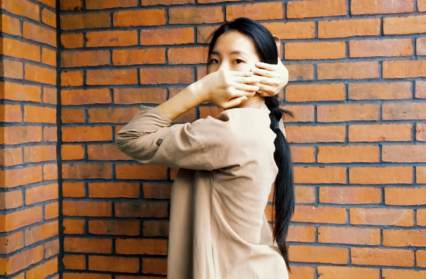Marine Furet reviews Plethu/Weave, a cross-artform collaboration between National Dance Company Wales and Literature Wales. The digital project allows dancers to choreograph movements to commissioned poems and reflect contemporary Wales through short solo performances.
Even as the autumn equinox already portends the onset of winter, Plethu/Weave presents us with a series of poetic video snippets offering a bite-size sensory escape. The brainchild of National Dance Company Wales and Literature Wales, the project currently includes four filmed choreographies that respond to short poems in Welsh, English, and (though briefly) Arabic. The poems deal with exile, slavery, the contradictory strands that make up Welsh identity, and that most elusive notion – Cynghanedd, or harmony. Four more videos are due to be released, all celebrating the collaboration between a dancer and a poet. While all the texts written for the project are commissioned by Literature Wales, the performers will be in equal part members of NDC Wales and independents – a positive gesture at a challenging moment for the performance sector at large.
One strength of the project is its attention to aesthetics in these times of sensory deprivation. Watching dance on screen (especially a laptop or a phone) may lack the excitement of an onstage performance, but allows for experiments with colour, lighting, texture, and settings that stretch the possibilities of both dance and poetry. While the brevity of the video-poems that make up Plethu/Weave imposes some constraints, all show a concern with form. ‘Triptych Part 1’, for example, intersperses choreographed moments performed by dancer Ed Myhill with vivid montages of poet Marvin Thompson in front of the sea. Thompson is alternately laughing and crying, his body covered in mud or drenched by the sea, while Myhill’s remains clean and statuesque, suggesting different ways of inhabiting and making home for oneself in a land enriched by slavery. The poem, a letter addressed to Brecon City Council in protest against a plaque honouring the legacy of a Welsh Slave trader, is the most historically specific text out of ones that make up the Plethu/Weave series, questioning the ambivalence of Wales towards its own links with imperialism. The video plays with textures – liquid, solid, grainy, smooth, harsh – to enact the schizophrenia of a culture that celebrates its racist heritage even as it purports to bolster a multicultural future. Contemporary in spirit, Myhill’s movements give a sense of strength that takes on chilling undertones when set against the suffering erased by the celebration of slavery and imperialism.
‘Ble Mae Bilaadi?’, born out of the collaboration of poet Hanan Issa and choreographer and dancer Aisha Naamani, feels more nostalgic. If, like ‘Triptych’, the piece also considers the difficulties of accommodating multiple identities, both the dance and the accompanying poem, which is written in English and Arabic, are an ode to the ability to make space for and contain multitudes, or, in Issa’s memorable words, to be ‘[l]ike a world pretending to be a city’. Naamani seems equally to be running to and from herself, as the camera follows her through Cardiff. Her chase is interrupted by movements of falling and starting again, each pause transporting her into another part of the city.
The two earlier instalments of Plethu/Weave are less concerned with historical specificity. Mererid Hopwood wrote her poem, ‘Hirddydd’, with the Great Clearance of Epynt Mountain in mind – a tragic event in Welsh history in which the communities living there were forcefully evacuated to give the Army a training ground for artillery. Yet, the video itself is set in dancer Tim Vollemann’s native Rotterdam, and takes a more impressionistic approach to the theme of harmony. The performance, which blends ballet and hip hop, is framed by scenes filmed in a room. Volleman’s convulsive contortions allude to a self left divided by an internal conflict, however this time the piece ends on an invitation to ‘Find the pattern that binds hearts’ and to embrace action rather than to give way to excessive introspection and worry. This expansive logic is followed by the intimate atmosphere of ‘Ust’ (Shh), a performance choreographed and edited by dancer Faye Tan and written by poet Ifor Ap Glyn. Shot in close-up, the video only reveals fragments of the dancer’s body – her bust and face, then her feet. The performance borrows from voguing and fluidly moves from moments of explosive energy to silence, all set against earthy tones and colours. Tan’s choreography is, as Glyn’s poem, both instantly striking and complex. Harmony, the performance seems to suggest, is a deceptively simple act.
It can be difficult to make a judgement about a work that is serial in nature – especially when it’s not over yet. Catching hold of Plethu/Weave at its midway point, I am intrigued by its variety and by the shortness of its components, which allows the viewers to catch up with the work of NDC Wales and up and coming other Welsh artists in fragments of less than two minutes. This work accommodates the viewer with a shorter attention-span, but the delicateness of the texts and performances rewards a more invested audience, making space for a poetic break in a day spent working from home. While not particularly hi-tech, there is also something suggestive about the concept of getting lost in the hyperlinks that surround the project, and learning, for example, about the composition process of ‘Usk’ at your own pace, either before or after the show. While the format would perhaps merit expanding to allow for more elaborate performances, Plethu/Weave has the potential to carry exciting possibilities for dancers and poets in Wales.
To find out more about Plethu/Weave, visit NDC Wales’ website.
You might also like…
Marine Furet reviews the final four performances of Plethu/Weave, a collaborative project between National Dance Company Wales and Literature Wales which sets unique dances to short poems.
Marine Furet is a regular contributor to Wales Arts Review.












